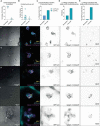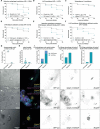Stimulating the autophagic-lysosomal axis enhances host defense against fungal infection in a zebrafish model of invasive Aspergillosis
- PMID: 35775203
- PMCID: PMC9809955
- DOI: 10.1080/15548627.2022.2090727
Stimulating the autophagic-lysosomal axis enhances host defense against fungal infection in a zebrafish model of invasive Aspergillosis
Abstract
The increasing prevalence of antifungal-resistant human pathogenic fungi, particularly azole-resistant Aspergillus fumigatus, is a life-threatening challenge to the immunocompromised population. Autophagy-related processes such as LC3-associated phagocytosis have been shown to be activated in the host response against fungal infection, but their overall effect on host resistance remains uncertain. To analyze the relevance of these processes in vivo, we used a zebrafish animal model of invasive Aspergillosis. To confirm the validity of this model to test potential treatments for this disease, we confirmed that immunosuppressive treatments or neutropenia rendered zebrafish embryos more susceptible to A. fumigatus. We used GFP-Lc3 transgenic zebrafish to visualize the autophagy-related processes in innate immune phagocytes shortly after phagocytosis of A. fumigatus conidia, and found that both wild-type and melanin-deficient conidia elicited Lc3 recruitment. In macrophages, we observed GFP-Lc3 accumulation in puncta after phagocytosis, as well as short, rapid events of GFP-Lc3 decoration of single and multiple conidia-containing vesicles, while neutrophils covered single conidia-containing vesicles with bright and long-lasting GFP-Lc3 signal. Next, using genetic and pharmacological stimulation of three independent autophagy-inducing pathways, we showed that the antifungal autophagy response improves the host survival against A. fumigatus infection, but only in the presence of phagocytes. Therefore, we provide proof-of-concept that stimulating the (auto)phagolysosomal pathways is a promising approach to develop host-directed therapies against invasive Aspergillosis, and should be explored further either as adjunctive or stand-alone therapy for drug-resistant Aspergillus infections.Abbreviations: DMSO: dimethyl sulfoxide; HR: hazard ratio; HDT: host-directed therapy; Hpf: hours post fertilization; IA: invasive Aspergillosis; LAP: LC3-associated phagocytosis; MTZ: metronidazole; PTU: N-phenylthiourea; ROS: reactive oxygen species.
Keywords: Aspergillus; autophagic defense; fungal infection; host-pathogen interaction; immunomodulation; innate immunity; phagocytes; zebrafish.
Conflict of interest statement
No potential conflict of interest was reported by the author(s).
Figures





Similar articles
-
The autophagic response to Staphylococcus aureus provides an intracellular niche in neutrophils.Autophagy. 2021 Apr;17(4):888-902. doi: 10.1080/15548627.2020.1739443. Epub 2020 Mar 15. Autophagy. 2021. PMID: 32174246 Free PMC article.
-
Macrophages target Salmonella by Lc3-associated phagocytosis in a systemic infection model.Autophagy. 2019 May;15(5):796-812. doi: 10.1080/15548627.2019.1569297. Epub 2019 Jan 24. Autophagy. 2019. PMID: 30676840 Free PMC article.
-
Distinct innate immune phagocyte responses to Aspergillus fumigatus conidia and hyphae in zebrafish larvae.Eukaryot Cell. 2014 Oct;13(10):1266-77. doi: 10.1128/EC.00080-14. Epub 2014 May 30. Eukaryot Cell. 2014. PMID: 24879123 Free PMC article.
-
LC3-associated phagocytosis: a crucial mechanism for antifungal host defence against Aspergillus fumigatus.Cell Microbiol. 2016 Sep;18(9):1208-16. doi: 10.1111/cmi.12616. Epub 2016 Jul 6. Cell Microbiol. 2016. PMID: 27185357 Review.
-
Interaction of phagocytes with filamentous fungi.Curr Opin Microbiol. 2010 Aug;13(4):409-15. doi: 10.1016/j.mib.2010.04.009. Epub 2010 Jun 2. Curr Opin Microbiol. 2010. PMID: 20627805 Review.
Cited by
-
P38-DAPK1 axis regulated LC3-associated phagocytosis (LAP) of microglia in an in vitro subarachnoid hemorrhage model.Cell Commun Signal. 2023 Jul 21;21(1):175. doi: 10.1186/s12964-023-01173-6. Cell Commun Signal. 2023. PMID: 37480108 Free PMC article.
-
DRAM1 Promotes Lysosomal Delivery of Mycobacterium marinum in Macrophages.Cells. 2023 Mar 7;12(6):828. doi: 10.3390/cells12060828. Cells. 2023. PMID: 36980169 Free PMC article.
References
-
- Aimanianda V, Bayry J, Bozza S, et al. Surface hydrophobin prevents immune recognition of airborne fungal spores. Nature. 2009;460:1117–1121. - PubMed
-
- Stop neglecting fungi. Nat Microbiol. 2017;2:17120. - PubMed
-
- Burgos A, Zaoutis TE, Dvorak CC, et al. Pediatric invasive aspergillosis: a multicenter retrospective analysis of 139 contemporary cases. Pediatrics. 2008;121:e1286–1294. - PubMed
-
- van Paassen J, Russcher A, and In ’t Veld-van Wingerden AW, et al. Emerging aspergillosis by azole-resistant Aspergillus fumigatus at an intensive care unit in the Netherlands, 2010 to 2013. Euro Surveill Bull Eur Sur Mal Transm Eur Commun Dis Bull. 2016;21(30):30300. https://www.nature.com/articles/nmicrobiol2017120 - PubMed
Publication types
MeSH terms
Substances
Grants and funding
LinkOut - more resources
Full Text Sources
Other Literature Sources
Medical
Molecular Biology Databases
Research Materials
